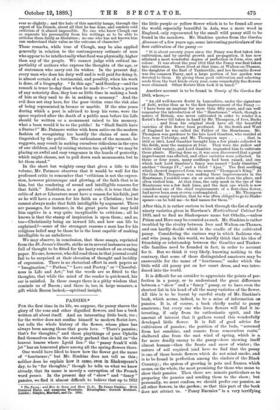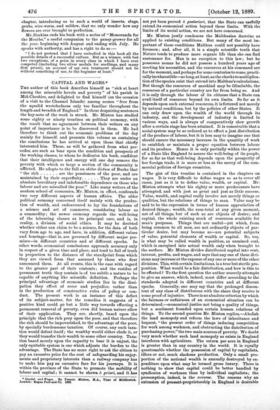PANSIES.* FOR the first time in its life, we suppose,
the pansy shares the glory of the rose and other dignified flowers, and has a book written all about itself. And an interesting little book, too ; for the writer does not confine himself to modern florist-lore, but tells the whole history of the flower, whose place has always been among those that poets love. "There's pansies; that's for thoughts ;" and these playthings of poor Ophelia find themselves also in the stately garland that is laid on "the laureat hearse where Lycid lies :" the "pansy fres,k'd with jet" has an honoured place among all the spring-flowers there.
One would have liked to know how the flower got the name of "heartsease ;" but Mr. Simkins does not tell us this ; neither does he explain how it came, even in Shakespeare's day, to be "for thoughts ;" though he tells us what we knew already, that its name is merely a corruption of the French word pensge. In the present day of " show " and " fancy " pansies, we find it almost difficult to believe that up to 1812 • The Panay: and How to Grow and Show ft. &e. By James Simkins. With Coloured Plates and numerous Woodcuts. Birmingham : Cornish Brothers. London : Simpldn, Marshall, and Co. 1W.
the little purple or yellow flower which is to be found all over the world, especially beautiful in Asia, was a mere weed in England, only represented by the small wild pansy still to be found in the meadows. Mr. Simkins quotes from the Garden Almanac of a few years ago, some interesting particulars of the first cultivation of the pansy :—
" It is about seventy years since the Pansy was first taken into cultivation, and by careful growth and propagation, it has now attained a most wonderful degree of perfection in form, size, and colour. It was about the year 1812 that the Pansy was first taken into cultivation. There lived at that time, at Walton-on-Thames, the daughter of the Earl of Tankerville, and her favourite flower was the common Pansy, and a large portion of her garden was devoted to them. By giving them good cultivation and selecting seeds from the best kinds every year, some remarkably fine flowers were obtained. Other florists then took it in hand."
Another account is to be found in Gossip of the Garden for 1863, where,— " An old well-known florist in Lancashire, under the signature of Dahl, writes thus as to the first improvement of the Pansy :— ' I have been an amateur for more than fifty years, and can well remember the introduction of the "Heartsease," which, though a native of Britain, was never cultivated in order to render it a florist's flower till taken in hand by Mr. Thompson, of Ivor, Bucks
and from his original stock have all the beautiful varieties of this flower been produced. In the South and West of England he was called the Father of the Heartsease. Mr. Thompson was gardener to the late Lord Gambier, who resided at
Iver, near tJxbridge, and Mr. Thompson says that in 1813 or 1814, Lord Gambier brought him a few plants collected in the fields, near the mansion at Iver. They were the yellow and white wild variety, and Lord Gambier requested him to cultivate these plants. Having done so, it was soon discovered that a great improvement was effected, and other varieties were collected. In three or four years, many seedlings had been raised, and one which took Lord Gambler's fancy was named "Lady Gambier," another "George IV.," and a third "Ajax." The first seedling which showed improved form was named " Thompson's King.' At the time Mr. Thompson was making these improvements in the Heartsease, I resided some six or seven miles from the place, and often visited him. At that time, the only mark in the eye of the Heartsease was a few dark lines, and the dark eye which is now considered one of the chief requirements of a first-class flower,
had never been seen or even contemplated Mr. Thompson raised so many varieties, that he was often obliged to go to Shake- speare—so he told me—to find names for them.'
After this, it is rather curious to look through the list of nearly ninety varieties given in Harrison's Horticultural Cabinet for 1833, and to find no Shakespeare name but Othello,—unless Priam and Hero may be counted as such. Mr. Simkins is rather troubled by the rivalry between Iver and Walton-on-Thames, and can hardly decide which is the cradle of the cultivated pansy. Considering the curious way in which fashions rise, and wits jump, in this world, we hardly think that his idea of friendship or relationship between the Gambier and Tanker- vile families need be founded in fact, in order to account for it. But we think it very likely, knowing nothing to the contrary, that some of these distinguished amateurs may be answerable for the name of "heartsease," under which the little wild old pansy put on her court dress, and was intro- duced into the world.
It is difficult for an outsider to appreciate the points of per- fection in a pansy, or to understand the great difference between a " show " and a " fancy " pansy, or to have even the shortest list in his head of all the many varieties of the flower. All this is to be learnt by careful study of Mr. Simkins's
book, which seems, indeed, to be a mine of information on pansies. It is, of course, a book chiefly useful to pansy amateurs ; but every one who loves flowers will find it in- teresting, if only from its enthusiastic spirit, and the
amount of interest that it gathers round this wonderfully
developed little flower. It is full of good advice for cultivators of pansies ; the position of the beds, "screened from hot sunshine, and remote from remorseless roots,' sheltered also from the mat wind of spring, which is a far more deadly enemy to the pansy—here showing itself
almost human—than the frosts and snow of winter ; the nature of soil required (and here we find that the pansy is one of those heroic flowers which do not mind smoke, and is to be found in perfection among the cinders of the Black
Country) ; the system of growing in pots and frames, which seems, on the whole, the most promising for those who mean to show their pansies. Then there are minute particulars as to, preparing the pansies and sending them to the show ; but personally, we must confess, we should prefer our pansies, as. all other flowers, in the garden; so that this part of the book does not attract us. "Pansy Enemies" is a very terrifying
chapter, introducing us to such a world of insects, slugs, grubs, wire-worm, and mildew, that we only wonder how any flowers are ever brought to perfection.
Mr. Simkins ends his book with a series of "Memoranda for the Months," a useful companion to the pansy-grower for all the year, beginning with August and ending with July. He
speaks with authority, and has a right to do so :—
"I do not pretend that I have embodied in this book all the possible details of a successful culture. But as a winner, with but two exceptions, of a prize in every class in which I have ever competed (including two silver medals for seedlings, and many first prizes), an account of my own treatment should not be without something of use, to the beginner at least."



















































 Previous page
Previous page